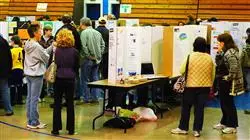University certificate
The world's largest faculty of education”
Introduction to the Program
This Postgraduate diploma in Programming in Educational Project Implementation generates a sense of confidence in the performance of your profession, which will help you to grow personally and professionally"

This Postgraduate diploma promotes an overall vision that will enable the implementation, or transformation, of educational projects that are intended to constitute the essence of the center, whatever their nature. Thanks to this program, educational centers will be able to build the appropriate knowledge, the fundamental pillars of the educational project taking into account each and every one of the factors that must be addressed in the process of programming and implementation of educational programs. Otherwise, schools are doomed to the vagaries of fashion, to fruitless waste of time and money, and most importantly, to fail to achieve a sufficiently stable path for students to walk on and develop their full capabilities and potential.
This program is unique because it manages to offer the necessary tools to build this core of the educational center so that it can last over time, be viable and, of course, be efficient. In addition, the teaching staff has extensive personal and professional experience in all types of educational projects, which means that this Postgraduate diploma is not developed from pure theory, but from the scientific evidence of practices in all types of educational centers.
On the other hand, the online modality ensures that the best experts and professionals in each of the areas of Programming and Implementation of Educational Projects can be found in the list of professors who teach this Postgraduate diploma.
Another of the reasons that make this program unique is the specialization in all the areas necessary for the Programming and Implementation of Educational Projects. While other programs focus on only a few aspects, the program we offer allows you to study each and every one of the fields that will make up the ideal construction of the educational project.
This Postgraduate diploma offers a very interesting overview of the programming and implementation of educational projects. Thus, every educational agent who studies this program will obtain one of the most useful skills in their professional career. Each and every center has its own educational projects. It is up to us to know how to program, manage, lead or implement them, in order to achieve the desired learning objectives of our students.
Update your knowledge through the Postgraduate diploma in Programming in Educational Project Implementation"
This Postgraduate diploma in Programming in Educational Project Implementation contains the most complete and up-to-date program on the market. The most important features include:
- Case studies presented by experts in Programming in Educational Project Implementation
- The graphic, schematic, and practical contents with which they are created provide scientific and practical information on the disciplines that are essential for professional practice
- Latest news on Programming in Educational Project Implementation
- It contains practical exercises where the self-assessment process can be carried out to improve learning
- With special emphasis on innovative methodologies in Programming and Implementation of Educational Projects
- All of this will be complemented by theoretical lessons, questions to the expert, debate forums on controversial topics, and individual reflection assignments
- Content that is accessible from any fixed or portable device with an Internet connection
This Postgraduate diploma is the best investment you can make when selecting a refresher program, for two reasons: in addition to updating your knowledge of Programming in Educational Project Implementation, you will obtain a qualification from TECH Global University"
It includes, in its teaching staff , professionals belonging to the field of Programming in Educational Project Implementation, who bring to this program the experience of their work, as well as recognized specialists from reference societies and prestigious universities.
The multimedia content developed with the latest educational technology will provide the professional with situated and contextual learning, i.e., a simulated environment that will provide an immersive program to learn in real situations.
This program is designed around Problem-Based Learning, whereby the educators must try to solve the different professional practice situations that arise throughout the program. For this purpose, educators will be assisted by an innovative interactive video system developed by recognized experts in the field of the Programming in Educational Project Implementation, with extensive teaching experience.
Increase your decision-making confidence by updating your knowledge with this Postgraduate diploma"

Take the opportunity to learn about the latest advances in Programming in Educational Project Implementation and improve your students’ education"
Why study at TECH?
TECH is the world’s largest online university. With an impressive catalog of more than 14,000 university programs available in 11 languages, it is positioned as a leader in employability, with a 99% job placement rate. In addition, it relies on an enormous faculty of more than 6,000 professors of the highest international renown.

Study at the world's largest online university and guarantee your professional success. The future starts at TECH”
The world’s best online university according to FORBES
The prestigious Forbes magazine, specialized in business and finance, has highlighted TECH as “the world's best online university” This is what they have recently stated in an article in their digital edition in which they echo the success story of this institution, “thanks to the academic offer it provides, the selection of its teaching staff, and an innovative learning method aimed at educating the professionals of the future”
A revolutionary study method, a cutting-edge faculty and a practical focus: the key to TECH's success.
The most complete study plans on the university scene
TECH offers the most complete study plans on the university scene, with syllabuses that cover fundamental concepts and, at the same time, the main scientific advances in their specific scientific areas. In addition, these programs are continuously being updated to guarantee students the academic vanguard and the most in-demand professional skills. In this way, the university's qualifications provide its graduates with a significant advantage to propel their careers to success.
TECH offers the most comprehensive and intensive study plans on the current university scene.
A world-class teaching staff
TECH's teaching staff is made up of more than 6,000 professors with the highest international recognition. Professors, researchers and top executives of multinational companies, including Isaiah Covington, performance coach of the Boston Celtics; Magda Romanska, principal investigator at Harvard MetaLAB; Ignacio Wistumba, chairman of the department of translational molecular pathology at MD Anderson Cancer Center; and D.W. Pine, creative director of TIME magazine, among others.
Internationally renowned experts, specialized in different branches of Health, Technology, Communication and Business, form part of the TECH faculty.
A unique learning method
TECH is the first university to use Relearning in all its programs. It is the best online learning methodology, accredited with international teaching quality certifications, provided by prestigious educational agencies. In addition, this disruptive educational model is complemented with the “Case Method”, thereby setting up a unique online teaching strategy. Innovative teaching resources are also implemented, including detailed videos, infographics and interactive summaries.
TECH combines Relearning and the Case Method in all its university programs to guarantee excellent theoretical and practical learning, studying whenever and wherever you want.
The world's largest online university
TECH is the world’s largest online university. We are the largest educational institution, with the best and widest online educational catalog, one hundred percent online and covering the vast majority of areas of knowledge. We offer a large selection of our own degrees and accredited online undergraduate and postgraduate degrees. In total, more than 14,000 university degrees, in eleven different languages, make us the largest educational largest in the world.
TECH has the world's most extensive catalog of academic and official programs, available in more than 11 languages.
Google Premier Partner
The American technology giant has awarded TECH the Google Google Premier Partner badge. This award, which is only available to 3% of the world's companies, highlights the efficient, flexible and tailored experience that this university provides to students. The recognition as a Google Premier Partner not only accredits the maximum rigor, performance and investment in TECH's digital infrastructures, but also places this university as one of the world's leading technology companies.
Google has positioned TECH in the top 3% of the world's most important technology companies by awarding it its Google Premier Partner badge.
The official online university of the NBA
TECH is the official online university of the NBA. Thanks to our agreement with the biggest league in basketball, we offer our students exclusive university programs, as well as a wide variety of educational resources focused on the business of the league and other areas of the sports industry. Each program is made up of a uniquely designed syllabus and features exceptional guest hosts: professionals with a distinguished sports background who will offer their expertise on the most relevant topics.
TECH has been selected by the NBA, the world's top basketball league, as its official online university.
The top-rated university by its students
Students have positioned TECH as the world's top-rated university on the main review websites, with a highest rating of 4.9 out of 5, obtained from more than 1,000 reviews. These results consolidate TECH as the benchmark university institution at an international level, reflecting the excellence and positive impact of its educational model.” reflecting the excellence and positive impact of its educational model.”
TECH is the world’s top-rated university by its students.
Leaders in employability
TECH has managed to become the leading university in employability. 99% of its students obtain jobs in the academic field they have studied, within one year of completing any of the university's programs. A similar number achieve immediate career enhancement. All this thanks to a study methodology that bases its effectiveness on the acquisition of practical skills, which are absolutely necessary for professional development.
99% of TECH graduates find a job within a year of completing their studies.
Postgraduate Diploma in Programming in Educational Projects Implementation
Programming in Educational Project Implementation is a discipline that combines programming technology with pedagogy to develop and implement innovative educational projects. In this field, professionals use programming skills to create applications, platforms and interactive resources that enrich the learning experience of students. If you want to specialize in this area, TECH Global University has the ideal program for you. The Postgraduate Diploma in Programming in Educational Project Implementation will lead you to learn relevant programming languages and how to use them to create interactive educational applications and resources that enrich the learning experience. Our program focuses on the development of innovative and high quality educational projects. You will gain knowledge about instructional design, gamification, online reality and other modern methodologies that enhance student interest and engagement.
Specialize in Programming in Educational Project Implementation
To achieve our goal of being the best online university in the world, we use innovative methodologies, classes supported by multimedia material and relearning teaching models that together will achieve a dynamic and efficient educational process. Here, you will have the most innovative learning methodology that will allow you to learn in a totally organic and efficient way. As you progress through the program, you will learn how to implement educational projects to ensure your success. Our experienced instructors will guide you on how to effectively integrate technology tools into the classroom and maximize the positive impact on the teaching and learning process. Upon successful completion of the Postgraduate Diploma, you will receive a recognized university certification, endorsed by our prestigious educational institution. This certification will open up new career opportunities in the field of education and educational technology.







